
|

|
October 26, 2006. "[The] 'local and temporary setbacks' like the present US government-as though that regime were an electoral aberration, rather than the harbinger of a drastic transformation of the world order that we will probably have to live with for as long as we can foresee. -Terry Eagleton
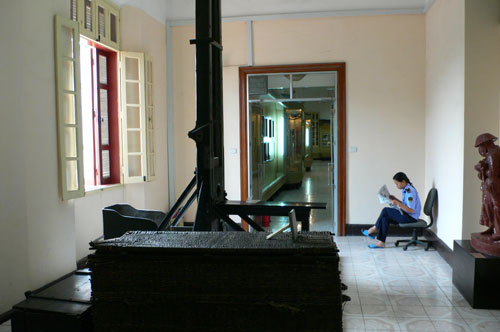
Out to Ciputra this past evening; frightening how quickly things are changing here. A gated community beyond the West Lake on a huge plain, it will eventually be called Citra West Lake City with "a championship golf course, low and high rise housing; a diplomatic precinct; a foreign investment centre; hotel; serviced apartments; medical centre; hospital; and schools."
Ciputra is the name of the founder of an Indonesian development company:
Never satisfied with the conventional, Ciputra always seeks innovative solutions that will enhance and improve each development. As early as 1961, Ciputra and the Jaya Group reversed the traditional approach to city planning by creating Indonesia's first "Island Concept" shopping centre, in which the retail orientation faced inwards, onto an attractive central plaza, instead of onto the surrounding streets.
They began with projects that turned away from the streetscape, the element that Jane Jacobs described as the key ingredient in a healthy city. The company has a website devoted to the founder, who is described as a visionary. He compares building the company to creating a waterfall. Another page called "The Vision" quotes Kahlil Gibran: "I feel within me, a hidden power that wishes to dress its nakedness in the garment of great deeds."
Many of the still unoccupied houses made the place seem a little spooky. It was hard to find the address I was looking for. I immediately hated being there. All the houses were alike. The site was chosen because it's on the lake and on the way to the airport. I don't know what was leveled to make room for it. Guarded affluence as a kind of poverty. Ciputra is one of the places where the economic oligarchy circles the wagons.
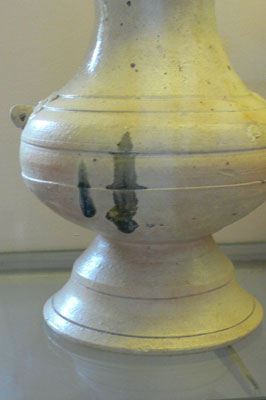 In the past two days, I have been to two Vietnamese museums, the Hoa Loa prison and the Museum of the Revolution, where everyone was very friendly, including a group of soldiers who were being led around by a lecturer. I have seen two guillotines. This country does not want to let their citizenry forget what the French did to anti-colonialist martyrs and revolutionaries. The Revolution Museum has the most humble assortment of objects to commemorate the struggle: Old scarves that a revolutionary wore before dying, handwritten manifestos, a cracked and chipped teapot that was used on an important occasion. A tattered flag, an old, worn bandana. I thought, "Perhaps they will understand my work here." For me, it was yet another instance of finding more than I bargained for.
In the past two days, I have been to two Vietnamese museums, the Hoa Loa prison and the Museum of the Revolution, where everyone was very friendly, including a group of soldiers who were being led around by a lecturer. I have seen two guillotines. This country does not want to let their citizenry forget what the French did to anti-colonialist martyrs and revolutionaries. The Revolution Museum has the most humble assortment of objects to commemorate the struggle: Old scarves that a revolutionary wore before dying, handwritten manifestos, a cracked and chipped teapot that was used on an important occasion. A tattered flag, an old, worn bandana. I thought, "Perhaps they will understand my work here." For me, it was yet another instance of finding more than I bargained for.
At the Museum of the History of Vietnam were two of the most beautiful things. One was an elegantly proportioned ceramic vessel. It had a dribble of green glaze down one part of the face that hung underneath as it turned in and another globby drip next to it. Out behind the museum was a school that was also from the colonial period. A stairway had been built that had accommodated a large tree. The tree had begun to grow onto the stairs, a grandmother resting its knuckles. Of course, at a time before air conditioning every tree made a difference. But still, were there no trees worth saving in Ciputra?
When I was a little boy on Staten Island, they were tearing down woods all the time. Whatever patch of woods I was playing in soon became rows of Cape Cods and split-levels. There were a number of huge trees that went down in the process; it must be one of my earliest memories, feeling the ground shake when they dropped. Staten Island was settled early enough that it wasn't thoroughly clear-cut like the rest of the Eastern Seaboard. It took the first baby boom to finally wipe out those old stragglers.
There's a line in a recent Village Voice art review that has gotten under my skin: "As appalling as expressionism can be, however, it is also frequently a powerful door-opener; it's better than spending a lifetime as a self-satisfied 100th-generation School of Paris painter." I like the School of Paris, even now. And here, the School of Paris that we have been taught to disdain has been, until recently, the last modern movement. There are older Vietnamese artists who do the kind of work that was set asunder by the New York School, the critics, etc. When I was in Paris in the spring, there was an exhibition, l'Abstraction Lyrique at the Musee de Luxembourg. I went with the painter Jerome Boutterin. There were a lot of artists that no one in NYC has probably ever heard of, and they would most likely giggle at their work if they were, in fact, known. Van Velde, Riopelle, de Stael, and some great early Martin Barre. And lesser-knowns who invented the style that has cheapened into the palette-knife painting that was so dominant in the later '50s. Jerome, who was studying the show very seriously, asked me what I thought. I said, "This is what a lot of the work looks like in Vietnam right now." I had another occasion to say that, when I was asked what I made of Jenny Saville's painting. I said that her painting style was like Vietnamese tourist painting.
Aspects of the School of Paris remain here and are delightful. I thought one of the definitions of postmodernism was that there was no more historical impetus and all styles were equal. Or does that just mean equal to ironize? Because painting is a debased medium that has a corrupt history, unlike rock 'n' roll-the ideal that most contemporary painting aspires to-which the U.S. army blasted as they invaded Panama, or hip-hop, which they use to torture political prisoners with. Isn't that a bit like a Kahlil Gibran poem being used by a huge, exploitative developer?
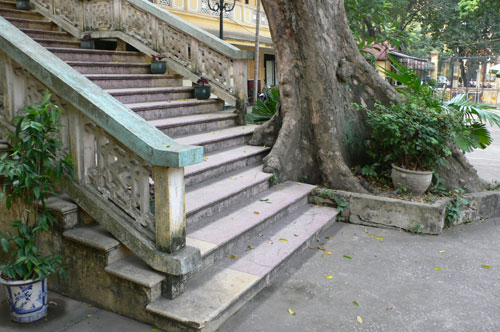
I digress. The School of Paris. I wandered past a little French-Vietnamese restaurant the other day. I noticed the word pČté among the menu's Vietnamese lettering, and I was waved in by a waiter, who took my bicycle and who led up me the slippery back stairs to a small dining room, full of Vietnamese who must have been working nearby. Men and women sat together, not necessarily the usual thing at lunchtime. Across from my table on the wall was a rather dark semi-abstract painting in a frame. It had a criss-cross of thick, dark lines, and certain sections were more colorful, palette-knifed textures. Across the bottom were three hooded figures, not mysterious, but more like going to church. Somebody was communicating something in this part-Léger, part-Rouault style. It held my gaze through the mineral water, crab soup, pČté, baguette (very airy, white flour, non-artisanal), the rabbit with mushrooms, and then the espresso. (100,000 Dong, about $6.)
October 22, 2006. The U.S. Embassy in Hanoi has two steel shipping containers filled with concrete sitting on the street directly in front of it. The Vietnamese still ask the people at the Embassy why they had to build such an ugly building.
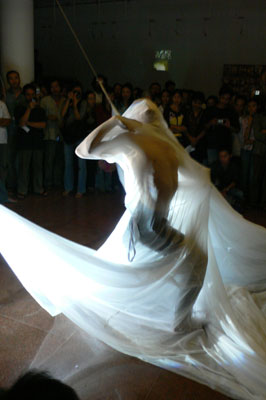 I am told that a common local expression is, "Hanoi is as small as your nostril," which means that everybody knows everybody. At the opening of Art Vietnam Gallery's exhibition "Hope Box Art Event," I see a number of people I met during my prior visits. Some of the main characters in Hanoi's bohemian circle, circa 1998, had appeared in Anh Hung Tran's Vertical Ray of the Sun, released in 2000. Just as the main character in that film goes through many suitors, many of Hanoi's better-known artists flip quickly through the scenes. I was looking forward to the exhibition because I had only seen the artist Tran Trung Tin's work in reproduction, but in person I am most affected by it.
I am told that a common local expression is, "Hanoi is as small as your nostril," which means that everybody knows everybody. At the opening of Art Vietnam Gallery's exhibition "Hope Box Art Event," I see a number of people I met during my prior visits. Some of the main characters in Hanoi's bohemian circle, circa 1998, had appeared in Anh Hung Tran's Vertical Ray of the Sun, released in 2000. Just as the main character in that film goes through many suitors, many of Hanoi's better-known artists flip quickly through the scenes. I was looking forward to the exhibition because I had only seen the artist Tran Trung Tin's work in reproduction, but in person I am most affected by it.
One of the younger artists that I speak with at the opening was having trouble with Tin's work because he didn't understand abstraction. Tin, a self-taught artist, was a Vietnamese film star earlier in life, and by the middle of the American War, he was stuck in Hanoi making counter-revolutionary abstract paintings, or nudes, on found newspaper. This current exhibition has a dozen of his works from '70-'73, and they are almost all abstract. The works are very simple and brushy in fairly somber, rich colors, mostly lines, dots, and dashes, that seem sometimes to play off the grid of newsprint images underneath and sometimes to ignore it. With a very basic vocabulary, the work evokes an imaginative spirit dwelling in a dark moment. Tin's works came from his wife's gallery in Saigon, on loan as a complement to the pieces of a Dutch artist named Rienke Enghart, whose work is an homage to Tin and is also being exhibited. Tin isn't at the opening. I had tried to meet him in May 2004 when I was last in Saigon, where he lives, but he was too ill to see anyone.
The next evening features "Viet-It," hosted by the Italian Cultural Council. It is Italian week in Hanoi, and following a fashion show and a display of Vespas custom-painted by Vietnamese artists, there is a juried exhibition of Vietnamese artists featuring a number of performances at Hanoi Fine Arts University. There was little in the way of painting to be seen. I see Mr. Augustin, the director of the Goethe Institute. The last time I was in town in 2004, he had given me the supreme compliment of saying how he had sent copies of my "Report from Hanoi" back to his superiors in Germany, because it gave a clear picture of the cultural situation in Vietnam. This time he didn't remember me. He looked around the show and said, "Very mixed, very mixed," which I guess is what diplomatic types say about shows that are very mixed.
The performances begin with the artist Nguyen Anh Duc completely rolled up in a fetal position in a big tent made of mosquito netting; he starts to come out of it and twist the fabric around, making a lot of profoundly existential movements that he combines with this Loie Fuller light, fabric, and music thing. I groan to myself that this is standard art school stuff. It should have been terrible, but it is actually pretty good. He looked great, with a sinewy body and very precise movements. As he lifts the fabric into a square tent that he then moves around in, there is always sculptural clarity. In another performance, Phan Le Chung, his body painted red, moves slowly across some black ink drawings on white paper that were part of the exhibition.

I spend a lot of time moseying around on my bicycle. It is easier on Sunday morning when I come across the peaceful settlement around Truc Bach Lake, to the north of where I am staying, but I am mostly in the thick of motorbike traffic looking anomalous and drawing the occasional quizzical stare. It makes me feel silly, especially riding with stretcher bars over my arm, like the last Romantic or something. The artist Vu Thu tells me not to worry about it. "They probably think you are one of those English teachers without much money," she says.
I am surfing the Internet looking for the line from Apollinaire's "Vendemiaire" that goes something like, "I was born in the time of the death of kings." It is easy to see what kind of time one has been born into over here. The ancient-looking peasants come into town on their old motorcycles and bicycles, or they run through the streets balancing loads of dusty, pared root vegetables. There are plenty of crumbling buildings, some that go back a century or more, and new, modern ones right behind them. There seem to be more cars every day. The swarms of traffic intensify around early morning and early dusk, when the new consumer class, still mostly on scooters, are going to and from work. They seem almost to split open the tree-lined roadways as they roar through.
I keep thinking that the city could be saved with a subway system. There are beautiful women in dust masks going by on motor scooters. They always remind me of the fashion among women in the Paris of Second Empire, wearing dust masks as Haussmann's reconstruction engulfed the city.
Something is passing here. I am watching as the whole planet becomes a city. Baudelaire observed something similar as Paris cracked open from its medieval warren. He saw it as a return to the miasma, or, according to Benjamin, the submarine. Some people like Baudelaire or Apollinaire weren't happy unless they were living in some kind of coda. Maybe I'm like that, too. On the other hand, unlike what happens to Nature in the suburbs of America--or now, "Exurbia," I guess it's called--my attraction has more to do with how nature isn't clubbed to death like a baby seal. I have never understood how a lot has to be cleared in the States for a McMansion to rise on tabula rasa. We keep trying to regain our virginity, the Eternal American Fresh Start.
In Hanoi, where they have torn down some probably great old building to put up a glass and masonry monstrosity, they seem to be able to keep the trees around the perimeter of the lot. Huge viney trees expand their trunks between buildings. Roses cascade from sooty balconies above the din. This isn't to say that the environment isn't being murdered here, too. It's just that it's happening in a more charming way.
October 20, 2006. Earlier, I had been to this local restaurant down by the market near the train tracks for lunch. It was full of people sitting on plastic stools around low tables with hammered tops eating away. One of the young girls--they all look about 17--brought me a bowl of fresh peanuts and pointed to this beef and potato thing, to which I nodded. Ten minutes later, she served me the Vietnamese version of steak frites: a pile of strips of beef and serrated-edged potatoes lying on top of two kinds of greens. I ate it happily thanks to the plentiful garlic that had been cooked with the meat, placing three little garlics on every piece of potato, mopping up the greens with the meat. It was really good.

So today, I go back and point to the dish on the table next to me. Soon I am digging into a deep-fried bean curd in a hot sweet sauce, with good body, the softest I have ever had. I also order the marinated beef with mushrooms, but this time I am brought a clay pot with a sizzling stew of every part of the beef that wasn't used elsewhere; I can't identify any of it. It must have been guts and brains and knuckles, all chopped up with some local celery and ear mushrooms. I am put off, the textures are so completely unfamiliar, and I cringe as I bite into these queer things. But I keep eating. It's really good, and gets better and better. It has a lovely pungent brown sauce, medium hot with some chilies.
 For the moment, I am working on paintings for a show instead of traveling or seeing people all day. I have lunch dates and go to events at night, but otherwise I work. I have already been to St. Joseph's Cathedral a few times. It is nearby, and it is one of the few Catholic churches I can enter without getting the creeps (my childhood contained too many miserable hours at mass, too many humiliating nuns, etc.). The cathedral's proportions are beautiful for a Gothic church from 1886, and the faćade reveals itself more fully due to its slow accumulation over the years of soot and water damage. It is on the most peaceful square in Hanoi that I know of. The Lonely Planet guide, world renowned among philistine travelers, describes it as "in dire need of a paint job."
For the moment, I am working on paintings for a show instead of traveling or seeing people all day. I have lunch dates and go to events at night, but otherwise I work. I have already been to St. Joseph's Cathedral a few times. It is nearby, and it is one of the few Catholic churches I can enter without getting the creeps (my childhood contained too many miserable hours at mass, too many humiliating nuns, etc.). The cathedral's proportions are beautiful for a Gothic church from 1886, and the faćade reveals itself more fully due to its slow accumulation over the years of soot and water damage. It is on the most peaceful square in Hanoi that I know of. The Lonely Planet guide, world renowned among philistine travelers, describes it as "in dire need of a paint job."
October 18, 2006. Pham Ngoc Duong, one of the younger Hanoi artists, whose work I previously reviewed for Art on Paper, comes by on his motorbike, and we go over to this place called Campus Hanoi, situated in a colonial villa in a quiet cul-de-sac. It's a beautiful house with hardwood trim, windows, and doors. After 150 years of tropical heat, everything is still closing properly. I always find this amazing. There are several Western artists in residence, paying $300 a month, and I meet one woman who is making a painting on the ground floor.
Campus Hanoi's website stresses that it is not a hide-and-work residency, but is about collaboration. Marcus Mitchell is the director. The three of us walk to get some lunch at a little Bun Bo place on the next street. Marcus studied French and contemporary art, and we discuss Relational Aesthetics, which he endorses ("Aesthetic theory consisting in judging artworks on the basis of the inter-human relations that they represent, produce, or prompt"-Nicolas Bourriaud). Alternately, I argue that if you stress the collaborative process in artmaking, you are going to leave out the introverted weirdos. (I include myself in this category: I have been thinking about introversion as a quality missing in most contemporary art and have, for the moment, identified it as the quality that I am most drawn to.) Marcus says he has heard this argument before, but points out that as I am here in Vietnam, and since I support and write about social-critical Vietnamese artists, then that is the essence of collaboration. Point taken.
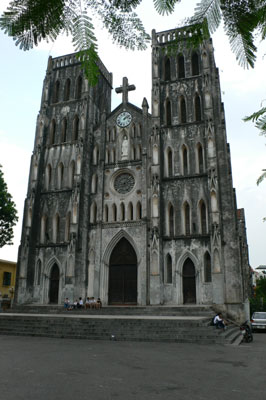 As we walk back to the villa, we look at the food stalls along the street. Duong says that these stalls are all selling dog food-for people. What looked like duck earlier to me was, upon closer inspection, quartered dogs with that dark shellac appearance from careful roasting. These stalls are full of men eating dog. I learn that the latter part of the month is considered lucky for eating dog, and that eating it early in the month is unlucky. Marcus asks if I am interested in trying it, and I tell him that there was a time in my life when I made a point of trying everything at least once, but that that time had passed. Duong said he has never eaten it, because when he was a child, his father killed a dog right in front of him to eat for dinner, and he swore right then that he would never try it. And he hasn't.
As we walk back to the villa, we look at the food stalls along the street. Duong says that these stalls are all selling dog food-for people. What looked like duck earlier to me was, upon closer inspection, quartered dogs with that dark shellac appearance from careful roasting. These stalls are full of men eating dog. I learn that the latter part of the month is considered lucky for eating dog, and that eating it early in the month is unlucky. Marcus asks if I am interested in trying it, and I tell him that there was a time in my life when I made a point of trying everything at least once, but that that time had passed. Duong said he has never eaten it, because when he was a child, his father killed a dog right in front of him to eat for dinner, and he swore right then that he would never try it. And he hasn't.
Not long ago, an unexploded American missile was discovered within Hanoi's city limits. There are still a number of Vietnamese killed regularly by American explosives left over from the war. The central part of the country, also the poorest part, comprises mostly illiterate peasants who are just barely surviving. The Americans mined this area, near the Demilitarized Zone, more heavily than any other part of Southern Vietnam. The locals have rigged up all kinds of metal detectors, because there are bonanzas of scrap metal if one is lucky enough to unearth an American tank or an airplane, which sometimes happens. But they don't know what they are going to get when that metal detector goes off and they begin digging. Sometimes a mine goes off.
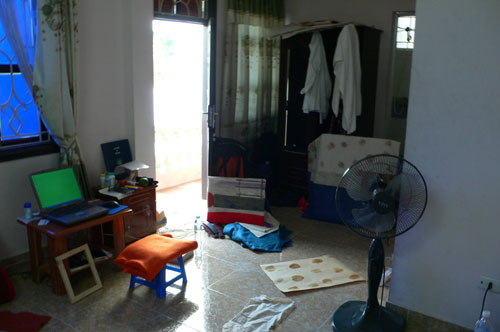
But sometimes it doesn't, and they will bring the mine home, put it on the kitchen table, and whack into it with a chisel to get at the gunpowder, which is also worth money, and risk blowing up half the village.
October 15-17, 2006. In the car from the airport, the burnt air hits my nostrils. It's like when I smell the dry musk of a typical Paris stairway—the same thought enters: "Oh, yeah, that." I am immediately reminded of why I return to Vietnam. I watch the passing silhouettes of the tall, skinny villas. Every light is out. At the Hang Nga Hotel, a young man who has been sleeping on a cot in the foyer lets me in. When I get to my room, I think it might have been the one I stayed in on my first trip. Some of the sheets have been used before, but at least they are cotton. I make up a fresh bed with what I brought with me.
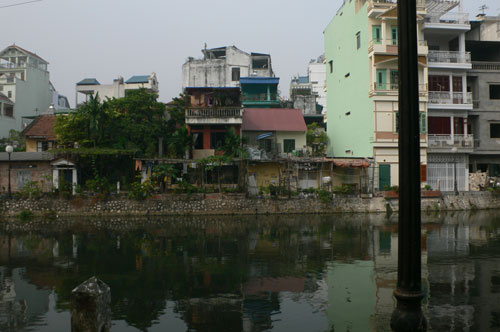
Walking out the next morning, the familiar din. I walk up through the Old City to the lake. The old people are doing their exercises and playing badminton on the sidewalks, and the motorbike traffic rushes everyone else off to work and school. The polished and starched kids on their bicycles, amid the others.
I decide to relocate to another hotel a block or so from the lake. Lots of windows covered with blue plastic to keep out the sun. The staff moves out most of the furniture in my room so that I have room to work, and they string a DSL wire five floors down to the hotel lobby. I am set up within 24 hours of arrival. The artist Tran Luong had previously talked to the manager about my special needs, chatting with him about art in Vietnam, etc.-one of his great attributes, his belief in art and in Vietnam and how he can convey it to many different kinds of people-and had won the manager over.
Last night I had dinner with Tran Luong and his family, and I heard about the incident at the border last year. One of the most visible artists among the new breed to use various forms of performance to engage disparate audiences in thinking about Vietnamese politics, Tran Luong has also been the most closely watched by the government. He is also intermittently employed by various NPOs throughout the country, most notably the Goethe Institute. (Vietnam's Institute is the most active in Asia, having brought numerous exhibitions of Germany's most famous living artists to Hanoi in the past few years, in addition to its notable program of performing arts and its exhibition space hosting many performances by Vietnamese artists.)
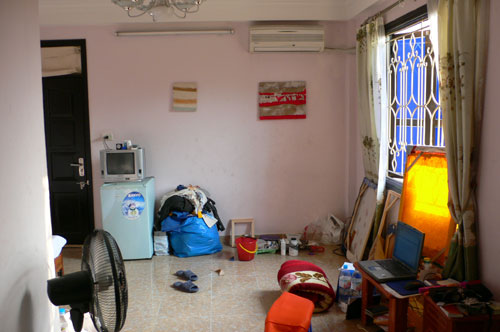
He had been with a group of younger artists, on their way to Cambodia to host a performance workshop, when he was detained and held at the border. No explanation, no warrants. Tran Luong wasn't sure if it was the government or the mob. It took three days for him to be released. He was used to having his phone and email monitored; this had gone on for years. Whenever there was some controversial art performance, the police would come and break it up. (Any show that took place at IPO venues was considered international territory and could not be touched.) Typically, Tran Luong thought that the government's spying created a situation that would only serve to change their attitude, because it would make them aware of the nature of his art. The incident at the border let him know that he was still under their thumb. But the last six months, he told me, they have been benign. They realize they must appear open and democratic to organizations like the WTO if they expect to do business.
It's good to have local food without the MSG so common in the pho you get on the street. I ate lunch in a place full of low-level bureaucrats near the hotel. The food had a homey mellowness, bits of pork and nuts amid the rice noodles and tiny watercress leaves. The same with the citrus: none of the sharpness we are used to in Western lemons and grapefruits. Skins very tough, though.
return to blog index
|

|